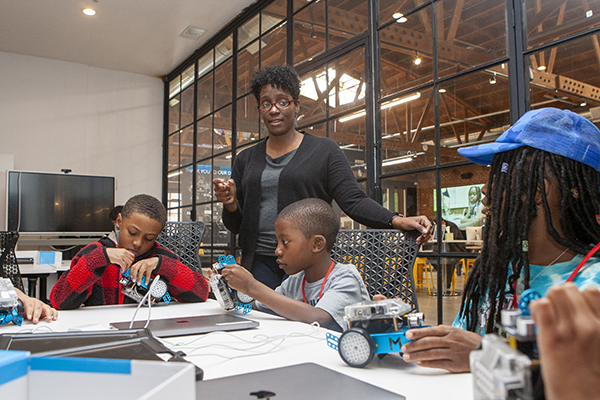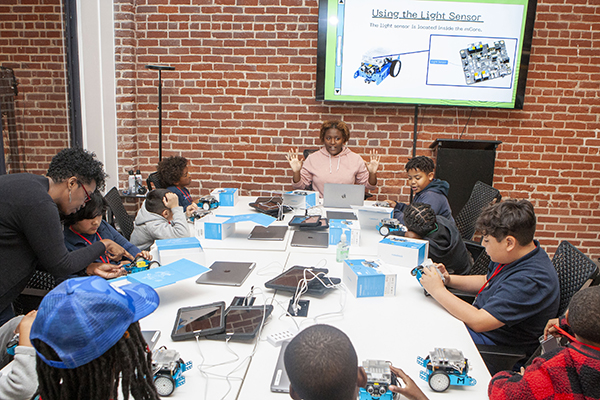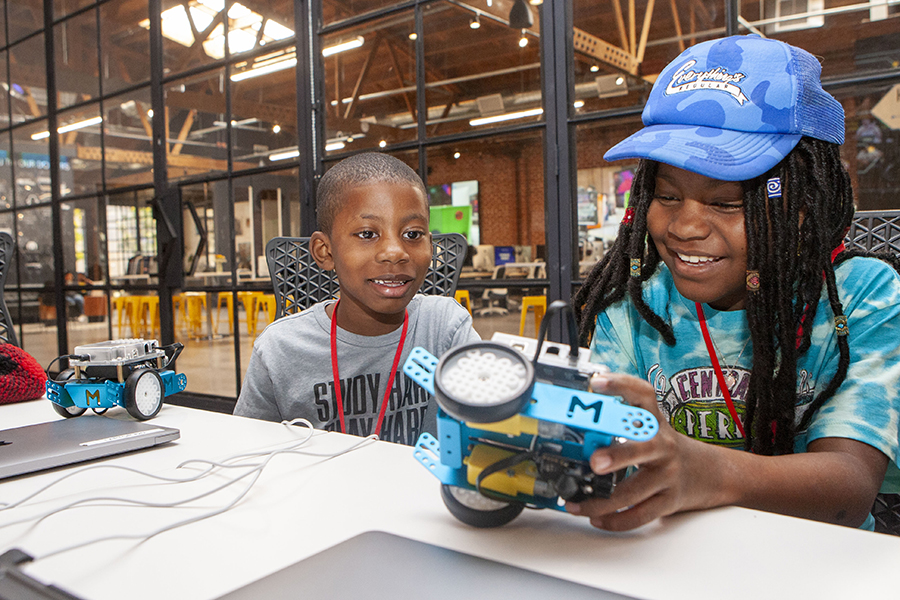SoLA Robotics is a STEM program that teaches coding through competitive robotics teams.


By Jason Lewis
Educator Jennifer Lashley founded SoLA Robotics after she took a group of students to a robotics competition at El Camino College. She quickly noticed that her team made up of children of color were the only team in the competition who were from that area.
“This is on Crenshaw Boulevard,” she said. “We’re not talking about way out somewhere. We were the only L.A. team there out of 36 teams, and we were the only Black and Brown team in the room. I’m looking around like, ‘where are the kids who live down the street?’ We found a local competition, but we were the only local team. So the next year we brought five teams with 20 kids.”
Lashley is a National Board Certified teacher with a Master’s Degree in Education from UCLA. She is a recipient of the Hero in Education Award, presented by LAUSD Board of Education District 7, for her work in STEM. She wanted to provide STEM instruction to students who did not have easy access to it, so should founded SoLA Robotics, which holds classes at the SoLa Technology & Entrepreneurship Center and at the South L.A. Best Buy Teen Tech Center, which is at the Vermont Slauson Economic Development Corporation. She teaches children how to code through building robots.
“With STEM we think about technology, apps, websites, programming, computer science, and things like that,” she said. “The reason why I teach STEM through robotics, or coding through robotics, is because it gives the kids something physical that they can build. You can imagine how much kids love Legos. They love to build it and they love to create new things. Robotics is not that different, but except in this case when they are finished they get to program it to complete a specific task. The way that the programming comes in is that they have to learn a coding language in order to program the robot to do the task. So it’s like a multiple step thing that we’re taking the kids through. They’re learning about engineering, how to communicate, about parts and censors, and they’re learning one or more programming languages. So it’s kind of an all around STEM activity where you’re hitting the science, technology, engineering, and the math through robotics.”
SoLA Robotics has classes for children nine years old through high school, and Lashley has recommendations for parents who have younger children.
Many college students who excel in STEM majors and go on to have careers in technology fields typically start taking STEM classes at an early age.
“It’s important for them to start early because we grab their attention,” Lashley said. “We start when they’re nine and ten, and they’re super excited. They just love to do this.”
Lashley points out that it’s never too late to to enter the STEM fields, as many high school students who were not exposed to STEM programs at younger ages can still participate and excel in the field.
Some students are intimidated in participating in STEM programs because their math skills may not be good, but Lashley said that students of all math levels can participate and that these programs can help improve their math skills.
“They can still participate because it’s all encompassing,” she said. “They’re not doing math 100 percent of the time. But there are times when they’re going to have to have some math skills. When we’re starting with kids who are nine and 10 years old, we’re not talking about calculus yet. We’re talking about centimeters per second, angles, speed, and things like that. And they learn it because it’s important for the robot to complete the task. So maybe they came into our class and they forgot what right angles were. We’re going to teach it to them again, and they’re going to get it every week until the robot can complete the task. So it’s not on the level where it’s rocket science. It’s still really fun.”

Children from more affluent areas have access to resources that allow them to excel at the robotics competitions, and Lashley is ensuring that her students have the same resources.
“Understanding the level that the other teams are working at made it easy for me to reach out to people in the industry and say, ‘Hey, we need some training over here too. Explain to us how this work,’” she said. “I have a few mentors in the robotics community who help us out and make sure that we’re up on things too. We can compete at the same level.”
SoLA Robotics, like other educational-based after-school programs, are not only preparing students for college and professional careers, but they also are life changing to at risk youths. For some children, a program such as SoLA Robotics services as a gang-prevention program.
“The most profound improvement that I’ve seen was more of an internal improvement for one student who was placed into after-school robotics because he was in trouble all of the time,” Lashley said. “He was a bully, really. He got in here kind of a last straw. He got in there and you just saw the leadership come out. At the end of the year for the graduation speech, he spoke about how being a part of a team was something that he had never done before. He had never had the opportunity of having other people depend on him, and that he wanted to make different decisions than some of the people in his family. For him it meant way more than just being on a robotics team. He can look back on that and say that this was a turning point.”
For more information about SoLA Robotics, visit www.southlarobotics.com and follow them on social media.











